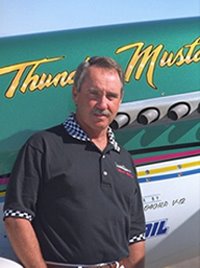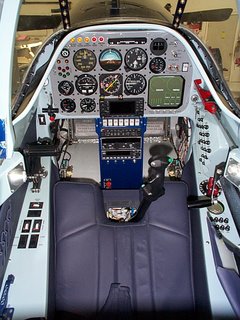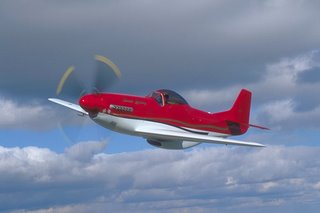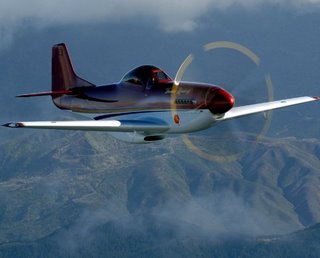
Papa 51 Ltd., Co. is proud to welcome
Dale M. Clarke to its family. Dale's extensive background in business, marketing and sales will enhance Papa 51's ability to serve the Thunder Mustang enthusiasts. As an additional plus, Dale's background in aviation promotes him to demonstration pilot status in the Thunder Mustang.
Flying Warbirds has been Dale's passion and much of his general aviation history. Now he is flying a kit built replica that will outperform many of the classics that he has personal experience in. Dale has flown nearly 75 different types of aircraft, from the standard certified spam-cans, to experimental aircraft and numerous Warbirds. His list includes: the P-51D Mustang, F4U Corsair, Fiat G-59, T-28, T-6, T-34, Sea Fury (T-MK11 & T-MK20), Commonwealth Boomerang, SF-260 Sia Marchetti, Antanov AN-2 "Colt", Boeing Steerman, NA-50 and Yak-3.

He holds an unlimited LOA for any high performance, single engine, piston powered airplane and has raced Unlimited's at Reno. He flew his first Reno Air Race in 1984 in a Sea Fury. Dale has flown aerobatics in everything from a Luscombe to a Sea Fury. This experience will come in handy in demonstrating the Thunder Mustang in the coming years.
Dale comes to us from Washington state, where he had been Vice President of Sales and Marketing and demonstration pilot for Stoddard -Hamilton Aircraft Inc. As you will read below, Dale gives us his impressions and experiences with the Thunder Mustang. Way too much fun.
 -/-/-/-/-/-/-/-/-/-/-/-/-/-/-/-/-/-/-/-/-/-/-/Warbird pilot Dale Clarke gives his initial impressions of the Thunder Mustang
-/-/-/-/-/-/-/-/-/-/-/-/-/-/-/-/-/-/-/-/-/-/-/Warbird pilot Dale Clarke gives his initial impressions of the Thunder MustangMy first impression of the Thunder Mustang as it sits on the ramp, is that it looks like it is going 300 mph and nobody has even started the engine.
My flight begins with a walkaround inspection, noticing everything is like the P51D's that I'm used to, only just a little nicer somehow. Today, I feel just a little taller. Maybe I'm swollen with pride because I'm the new guy that gets to strap on this magnificent machine and roar off to beat the air into submission. Regardless, the preflight is straightforward and normal except I'm not looking for evidence of loose rivets.
With the walkaround complete, I ease down into the cockpit and grin. It feels like a reunion. It's all P-51. The instrument panel is right, the canopy jettison handle is where it should be, the throttle quadrant is positioned perfectly, except that it is missing the mixture control lever. That's nice, one less thing to worry about. Rudder pedals adjust like the North American brand and there is so much leg room I can't reach them. Even after moving them back towards me to get full travel, there is still lots of leg room. The cockpit is comfortable. I'm not going to flop around in it, but it's very comfortable. It feels larger than a Yak-3 and a little cozier than a Sea Fury.

The engine start makes a pilot look like he really knows what he's doing. Turn the key on, put the ECU (Electronic Control Unit) switches to "main" and "both", turn the boost pump on and press the start button. About three blades and those 12 short stacks all begin to sing in unison. No primer to worry about, no mixture to worry about, no stack fires, no popping or banging, just the rhythmic bark of the big V-12. The prop didn't even need to be pulled through. I like this.
Just like the original, push the stick forward to unlock the tail wheel and turn to taxi toward the runway. The visibility is outstanding, so good I'm tempted to ignore 'S' turning, but in the three point attitude, there is a blind spot over that long thin nose so I defer to safety and slowly weave right and left to clear the path in front of me.
The temperatures are up to normal. This takes a little while on a cool day because the gearbox has to be warm before a run-up. I go through the check list; brakes locked, hold the stick back, bring the engine up to 3000 rpm, cycle the prop, that's all normal. Now, I've been told about these ECU units and I know how to manipulate the switches, but I'm still a little baffled by this computer wizardry. Shut down ECU #1 and the RPM's drop to 2250 (it is amazing how the engine runs so smoothly on six cylinders) back to both and we're again at 3000 rpm. Shut down ECU #2 and again the engine is running smoothly at 2240/50 rpm. I'm told that in an emergency, the engine will get you home on six cylinders. As smooth as it is on run-up, I'm starting to believe it.
I can hardly wait to get cleared onto the runway, I want to get the Thunder Mustang into the air and go somewhere......fast. My right foot is ready as I push the throttle forward, straight to the stop. The mustang leaps like a sprinter out of the chalks but the hard left turn that I had anticipated is not there. Oh, you have to feed in a little right rudder, but that's all it takes to run straight down the center line. Just like an original, torque compresses the left strut so I apply right aileron. The tail comes up very quickly and the Thunder Mustang lifts off at about 100 mph.
Keeping the speed within limits while I retract the gear, the VSI reads well over 5,500 fpm and my climb angle is over 45 degrees. I love 'm, but no original P-51 ever did that. (On subsequent flights, I've used a shallower climb angle.) The Thunder Mustang rockets through 150 towards 200 mph and I'm still in the runway environment. This is more like a drag racer. I can't wait to find one of my old friends in a stock P-51.

Cruising along at 10,500 feet, 21 inches of mp and 3900 rpm, it's so smooth you would think you were behind a turbine. I almost don't believe my eyes, the GPS is reading nearly 300 kts, my fuel flow is 21/22 gph. Oh baby, you and I are going to go places. In level flight the visibility is spectacular. Still, I do some clearing turns so that I can start to play a little.
At 30 , 60 and 90 degree banks, the stick and rudder forces are light and will balanced. As the airplane G's up, it feels solid and more massive than its 23'8" wing span. It feels like a fighter. Stalls clean and dirty, power on and power off are all straight forward. There is very little pre-stall buffet, then a crisp break. Simply unload, the air reattaches and you fly away. There is no tendency for the airplane to try to jump over on its back. The airplane will actually do a series of stalls with no problem, unattach, reattach, unattach, reattach, and on and on.
Gentleman aerobatics, loops, rolls, Cuban 8's etc. are performed from level cruise flight. 4g loops result in arcs of thousands of feet. I'm amazed at the roll rate. It's better than 300 degrees per second. This Thunder Mustang is not only fast but it's a delight to throw around the sky.
Dan Denney was up in his Glasair III watching these antics. This is so much fun that I decide to go down and terrorize him a little. After warning him that I'm coming he firewalls it, but there is just not enough. The Thunder Mustang is on him in a flash. So fast that after I make a pass at him I do 360's around him, then a couple barrel rolls over him, followed by coming from below and doing five climbing aileron rolls up past his nose as I leave him behind. I tell Dan there are only two kinds of airplanes, fighters and targets. He tells me he doesn't like being a target. Whoops, I better treat the boss a little better if I want to keep my ride.
We head home as a flight of two, with Dan in the Glasair III and me in the Thunder Mustang. This gives us a chance to compare performance. Dan's airplane is quick, truing 235 to 240 kts, but not quick enough for my ride. As we cruise together Dan has the Glasair firewalled, he's burning 16 gph, I have to pull the Thunder Mustang way back. I'm showing 235 kts and 13 gph to keep from over running him. The mustang is so stable in formation I can take both hands from the controls and wiggle my fingers at Dan.
This thoroughbred wasn't meant to limp around at 235 kts. I roll off my station, bring the power up a little and let the nose point down hill. The Thunder Mustang is quickly approaching 400 kts, as I realize I've got one hand on the throttle quadrant and one hand on the stick. The control forces are still very nice, tighter, but very nice. If I were in an original P-51 the ailerons would be so stiff now I would be grabbing the stick with both hands.
As I near the airport I ask for the overhead approach. In the break I reduce the power and put out 10 degrees of flaps to help get rid of the speed. Gear down, put out the rest of the flaps, boost pump on, prop up and we're base to final at about 110 Kts. I never lose sight of the runway, the picture over the nose is terrific. It's 90 Kts over the fence and the speed bleeds off as I round out. The "spool up" of the large main wheels stakes me nicely to the runway. The Thunder Mustang tracks right down the center line and needs very little rudder correction as the tail comes down.

Taxi back to Papa 51, turn the ECU's off (remember, there is no mixture lever) and the music of the V-12 stops. Unwilling to climb out, I sit in the cockpit savoring this experience. The grin I started with when I left is still plastered across my face. My next opportunity to fly the Thunder Mustang can't get here soon enough.
___________________________________________________________________
 A look at what it takes to handle the Thunder Mustang By Dale M. Clarke
A look at what it takes to handle the Thunder Mustang By Dale M. Clarke One of the questions that we are often asked about the Thunder Mustang is "what do I need to do to prepare myself to fly this airplane?". It's a fair question and one I frequently answer almost without thinking, "it's very straight forward, you won't have any problem". This isn't a flippant response. Its just that, compared to the other Warbirds, the Thunder Mustang is a treat not only in flight but especially when it comes to ground handling in a high performance taildragger. It is here that I should adjust my perspective.
For most of us who have been flying Cessnas, Pipers, and Beechs, some preparation will be necessary. Anyone with reasonable motor skills, and the ability to follow instruction can be taught to fly a tailwheel airplane, or any airplane for that matter. After all, WWII saw the good ole' U.S. of A. teaching hundreds of thousands of 19 year old kids (my Dad was one of them) to fly the "big iron". Of course, it's a little different here, we're not 19 anymore and we've got a couple hundred thousand of our hard earned dollars invested in this beauty. So, how do we go about getting checked out?

If you don't have a tailwheel endorsement, this is the place to start. Any of the small taildraggers will provide an excellent base for acquiring tailwheel skills. A Champ, Citabria, or Luscombe would be some of the good choices. In truth, the fancy footwork needed to fly one of these is more than you'll need in the Thunder Mustang. After you've mastered the tailwheel airplane, and this really doesn't take long (3 to 5 hours to solo), you'll probably want to fly it for another 10 or 15 hours because its just so darn much fun.
Now it's time to mate your new found tailwheel skills to a higher wing loaded airplane. If you have a buddy with one of those old slow Lancairs or Glasairs (boy have I got some friends that are going to hate me for that!), they will approximate the wing loading of the Thunder Mustang.

The ideal transitional trainer is the venerable T-6. Like all great old warbirds, it's getting harder and harder to find someone that will throw you the keys or even rent you one. Some are available however, and if you can get in one it's worth a lot both in the experience you'll pick up and in the fun you'll have. Still, the Thunder Mustang is a walk in the park compared to the T-6.

Papa 51 Ltd. Co. is just as interested in getting you safely into the air as you are, and as such we've prepared a flight training syllabus that will help you reach that goal. If you have your tailwheel endorsement but haven't been lucky enough to fly the T-6 or any of the other big engine taildraggers, we can arrange transitional training in a Thunder Mustang.






















